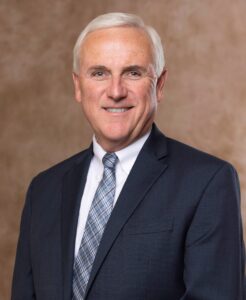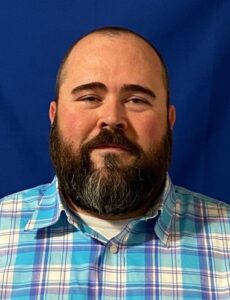Health care competitors become collaborators as COVID-19 reality sets in

When you hear the phrase, “in this together,” you may not envision long-time business competitors coming together to share ideas, processes and resources. This is exactly what is happening among a team of south central and southern Ohio health system leaders who are working together through the COVID-19 pandemic.
Ohio’s Region 7 Health Care Collaborative includes CEOs from Adena Health, Fayette County Memorial Hospital (FCMH), Holzer Health System, King’s Daughters Medical Center of Ohio (KDMC), and Southern Ohio Medical Center (SOMC). The collaborative came together to create an incident command center to coordinate regional care of patients suspected of having or testing positive for COVID-19, and for a potential surge in COVID-19 cases in the area. The collaborative has been a model for the state of Ohio throughout the pandemic.
However, these health care systems are no strangers to collaborating. Several members of the collaborative have already been working together to assure patients in our region have access to the care they need, close to home and family.
“It started more than two years ago, with a phone call between Mike Canady, CEO at Holzer and me talking about our shared vision for each of our organizations – to stay independent,” said Adena President and CEO Jeff Graham. “We started looking at how we could accomplish that, and how we start working together for the better good of the community. From there the conversations started to grow.”
Dr. Canady was having similar talks with former SOMC CEO Randy Arnett at the time, so with Graham, the three came together to discuss how the organizations might collaborate to achieve their common goals of independence and keeping care close to home. “I’m a firm believer that you can’t do business with someone you don’t have a relationship with,” said Dr. Canady. “The whole thing has been about recognizing that we all have a lot of similar interests and we have crafted some of our business opportunities around that.”
Two more CEOs joined the collaborative in its discussions. The now, five-member group included Jack Janoso, President and CEO of Fairfield Medical Center in Lancaster; and Mike Diener, CEO of Fayette County Memorial Hospital, located in Washington Court House. Last spring, the group held a formal work session with key members of their teams, discussing how they could work in partnership for the betterment of each other, and the communities they serve. Thoughts discussed included ideas such as shared purchasing opportunities or clinical services sharing.
“That was really the next phase of our collaboration,” said Graham. “What are the things we can do together to really keep the care close to home?” He added that even though each organization is trying to accomplish the same thing, they also remain competitive in their markets. “That will never change. But by having this collaborative, it really aligns the relationships and how we build off of each other in the services we provide or don’t provide within the region.”
The work group included SOMC’s new President and CEO Ben Gill, while still in his previous role. When named CEO, Gill was immediately onboard with nurturing the collaboration of likeminded competitors. “There is a tendency to think in absolutes when it comes to competition, and I don’t think that’s necessarily the case,” said Gill. “Competition has its place. But if the goal is to take care of the community we serve then there is also an obligation to collaborate.”
included SOMC’s new President and CEO Ben Gill, while still in his previous role. When named CEO, Gill was immediately onboard with nurturing the collaboration of likeminded competitors. “There is a tendency to think in absolutes when it comes to competition, and I don’t think that’s necessarily the case,” said Gill. “Competition has its place. But if the goal is to take care of the community we serve then there is also an obligation to collaborate.”
CEO Mike Diener of FCMH, which has a formal partnership with Adena for a number of shared specialty services said, “It has been interesting for us, because Fayette Memorial Hospital is located in a region that pulls us into the northern region and Columbus market. But organizationally, operationally, and culturally we have much more in common with the hospitals in the southern Ohio region. They have some of the same challenges and the same opportunities that we have. It is refreshing and encouraging to coordinate our activities with them. I feel FCMH is better prepared because of the relationships we’ve had with our health care partners in southern Ohio.”
To learn from their peers, the CEOs reached out to a group in northern Ohio that had formed a similar relationship. The southern Ohio team hoped to gain an understanding about how the northern Ohio group works together to enhance the availability of care in their respective region. Using what they had learned from their norther partners, the southern Ohio group began exploring how to move toward the next phase of their collaboration. “We started looking at the hospital collaboration that was working for northern Ohio, and then COVID-19 happened,” said Dr. Canady. “That has pulled us together even more — out of necessity. We all hang together or we all hang separately.”
Over the past six to eight weeks, the group has become formally known at the state level as Ohio’s Region 7 Health Care Collaborative, and is a model for other regions in the state. The relationships that have been built between the health care leaders continue to strengthen, and are benefiting the region’s response to the COVID-19 pandemic.
“Having this established relationship has really been a huge advantage for us in how quickly we pulled together the Regional COVID-19 Incident Command,” said Graham. “We were a step ahead of most regions in Ohio, because of how we and our teams had been building relationships prior to COVID -19. It was very easy for our teams to align and to assemble the necessary people and resources needed to establish a regional command center.”
Through the Regional Incident Command, there has been a great deal of teamwork at all levels. The collaborative teams quickly adopted a plan to use similar processes, and treatment area set-ups. This allows each entity to know on a daily basis how everyone in the region is prepared to care for their patients and to monitor volumes should they have to transfer patients in the event of a massive surge.
Along with the Incident Command, the CEOs have maintained at least weekly conversations to discuss high-level issues, including the challenges all health systems are facing because of the COVID-19 crisis.
“Any time there is a crisis you circle the wagons. I know we do here,” said SOMC’s Gill. “Everyone in the world is affected by this pandemic. We all need to work together, at least regionally, because we do share a lot of the same challenges and resources. It stands to reason we should work together to have a regional response to a regional problem. I think those relationships that were built before this began are really starting to bear fruit, and you can see that we are better because of it.”
Joining the collaborative as a direct result of the Coronavirus is King’s Daughters Medical Center Ohio Executive Administrator Curtis Meltzer, who expressed his gratitude for being added to the group as part of the Region 7 Health Care Collaborative’s pandemic response. “The work that has been done by this collaborative has been quite impressive,” he said. “I think the fact that you have leaders from five health care systems from throughout our region, who have been able to come together for our community is amazing in itself. The fact it has been done so fast, thorough, and cohesively is what really stands out to me.”
“The work we’v e done to build these relationships previously; and the closer we have become through the COVID-19 crisis, my expectation is that we come out of this even stronger,” Graham concluded. “I hope we continue to share innovative ways of working to be sure that we all come out of this strong, and we are each here for the long term, providing health care for our local communities.”
e done to build these relationships previously; and the closer we have become through the COVID-19 crisis, my expectation is that we come out of this even stronger,” Graham concluded. “I hope we continue to share innovative ways of working to be sure that we all come out of this strong, and we are each here for the long term, providing health care for our local communities.”
Dr. Canady added, “The more we can collaborate, without negatively impacting each other’s markets, the better off we all are.”
Unclear how long COVID-19 will be a part of their businesses and everyone’s daily lives, the leaders agree they want to continue the work together for the good of the communities and people they serve long after the crisis.
